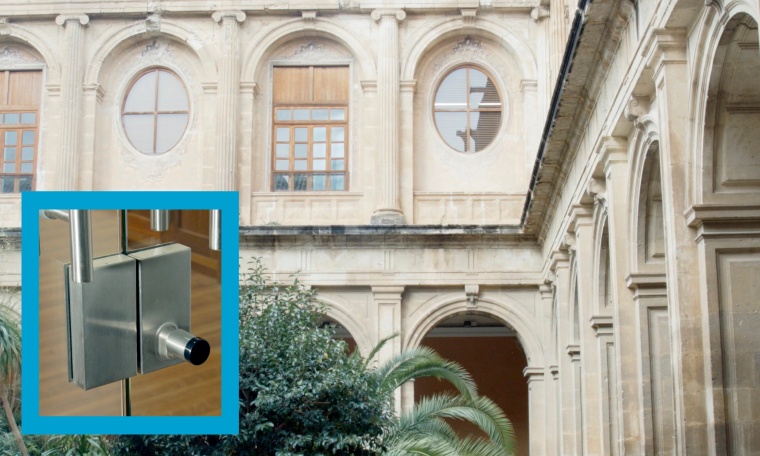Assa Abloy: 21st-century Locking for Old Buildings
Retrofitting modern security to old or protected heritage buildings used to be an installer’s nightmare. Wiring could be complex; damage to ancient architecture or door hardware was a constant risk. Now wireless access control devices which match the protection and durability of wired technology have made it straightforward.
For a facilities manager, the security remit for any building or space is broadly the same. People and assets must be kept safe. Access to the most sensitive areas should be carefully filtered. Intrusion has to be stopped. Yet installation, wiring and larger modifications present a unique set of challenges in an older building.
Battery-powered access control devices can add equivalent features wirelessly, at lower and more predictable cost, because no cabling is required around the door. In a wireless system, locks for doors, cabinets and other openings communicate over-the-air with a network of hubs. These may be placed close to existing mains power sources, minimizing disruption to the building fabric. Software makes the access decision which is communicated back to locks via the hub. Everything happens almost instantly and wire-free.
In an old building, choosing to wire for door security opens up not only expense but uncertainty. Indeed, when working under old floors and inside walls which are 100 years or more old, surprises are guaranteed. At installation stage, big surprises can be very expensive.
Aesthetics is another concern. Wireless access control cylinders, for example, offer durable, certified electronic security paired with a minimal visual impact. At a heritage property, low-profile security solutions are a must. In addition, replacing mechanical locks with wireless electronic door devices reduces the manual workload involved in handling and tracking physical keys - saving time and money for property managers.
Retrofitting 21st-century locks to a 16th-century building
In updating access control for one school property in Spain, installers faced precisely these challenges. The Colegio Diocesano Santo Domingo in Orihuela is more than just a school. Its historic buildings date to the 1500s. An on-site museum needs protection from the same access system. This is a heritage site as well as a place of learning.
Hence, the brief for a new access system required minimizing disruption on two fronts. The college buildings are a Resource of Cultural Interest and on Spain’s heritage registry: They must not be damaged. School leaders wanted to avoid disturbance to everyday learning. Wireless locks from Assa Abloy were the answer.
“In addition to the main entrances and classrooms, access to private spaces such as lifts, offices, staff rooms, the church, the museum, the library and the IT room is constantly monitored,” says the school’s IT Manager, Francisco Fernández Soriano. “Thanks to our Smartair devices installed at more than 300 doors, the security team can find out who has accessed which space and when, at any time. This increases security for children and for staff because no unauthorized people can enter the school.”
Installation of the school’s new Smartair system demanded little work. Some doors are 500 years old, so major alterations were not possible. Smartair door devices are easily fitted without drilling or wires. To install a Smartair cylinder, for example, a professional simply replaces the existing mechanical cylinder with the battery-powered Smartair device.
“The system was installed without a hitch and also without any disruption to classes,” confirms Soriano.
Adding flexibility for school and care home security
At the Vejle Friskole in Denmark, key management had been eating up “a very long time, approximately five hours a week,” explains Henrik Kækel, the school’s Technical Service Officer.
Now mechanical keys have also been replaced by a wireless access control system. More than 80 doors and cabinets around the school are secured with Smartair locks. At a historic property like Vejle Friskole, the customer required that devices were easy and unobtrusive to retrofit.
"It was really bad [before] because we had big problems with keys that were lost,” says Kækel. “There was a lot of work on keying in and handing out.” Today, Vejle Friskole staff spend around five minutes a week managing their access system.
“It's incredibly easy to figure out... it takes one minute to code a student,” he adds. Even managing the leasing of school buildings for non-school events is simple and secure. Facilities staff issue digital credentials for the duration of an event, then cancel them immediately afterwards via the software, with no concerns someone may have copied a physical key.
Pamplona’s Casa de la Misericordia, in Spain, also switched their century-old building from mechanical to electronic locking. To meet the day-to-day care needs of over 500 residents, they had a specific set of demands for a new access system. Real-time control over the premises was essential. “In a residence like ours it is critical to have real-time management that allows us to interact with a door at any time,” explains Ernesto Serra, Facility Manager at the Casa de la Misericordia.
The system also needed to be flexible and expandable, so it could be installed in two phases. Advanced wireless technology suited to retrofitting in an old building was another must-have: This 1930s building has large doors and walls up to one meter thick.
Serra concludes: “A wireless solution that allows us to install access control without wiring up the buildings is a big advantage, the system has adapted to our present and future needs."















